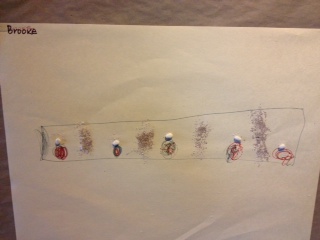I am in awe of these children. They have retained so much information about pollination, the mason bee life cycle and their homes. They have many answers and even more questions. They have requested to make a bee book project, which we will begin next week. Many children put in their thoughts on how the book should be compiled, what information should be in the book and how it should look. I am thrilled they are designing their own art projects now!
Below are a few examples of their replications of how mason bee tubes are filled. Look for nectar/pollen balls, eggs and mud walls. They know the terminology and understand the sequencing-yes, math is in everything!
Below are a few examples of their replications of how mason bee tubes are filled. Look for nectar/pollen balls, eggs and mud walls. They know the terminology and understand the sequencing-yes, math is in everything!
I am so looking forward to exploring these wonderful insects with them next week. They also want to learn about honey bees!
Emily







Comments